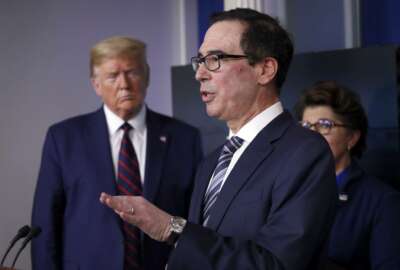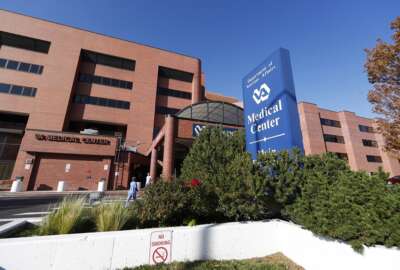Hubbard Radio Washington DC, LLC. All rights reserved. This website is not intended for users located within the European Economic Area.
Agencies utilizing 3D printing to fight coronavirus
The FDA, NIH, and the Veterans Health Administration now all have 3D printing capabilities. We discuss with VHAs Beth Ripley.
Best listening experience is on Chrome, Firefox or Safari. Subscribe to Federal Drive’s daily audio interviews on Apple Podcasts or PodcastOne.
Agencies are bringing three-dimensional printing to bear in the coronavirus battle. Now there’s a memorandum of understanding between two Health and Human Services agencies, the FDA and the National Institutes of Health, and the Veterans Health Administration. All three have 3D printing capabilities. For what’s behind and in the memo, Federal Drive with Tom Temin spoke with the director of the VHA’s 3D printing network, Dr. Beth Ripley. Read the full memo here.
Interview transcript:
Tom Temin: Dr. Ripley, good to have you on.
Dr. Ripley: Thank you. It’s great to be with you.
Tom Temin: So give us the background here. How does 3D printing, and I’ve seen the FDA lab where they make jaw bones and kneecaps and stuff out of whatever they make 3D printing materials, how does this help in coronavirus, which is something so small you can’t see it?
Dr. Ripley: It’s a great question. And you know, if you had asked me that a month ago, I would have told you 3D printing has nothing to offer. But times are changing and we’re finding new ways every day that it actually really does apply, and where it’s really shining right now is allowing us to rapidly prototype and fabricate things that are needed on the frontline, such as personal protective equipment in order to fulfill gaps in supply chains.
Tom Temin: Got it? And so that’s something clearly HHS and Veterans Affairs Department need, because you’ve got so many people on the front lines. And what is the memorandum of understanding all about?
Dr. Ripley: It’s really about trying to help the public and our health care organizations really hone in on the 3D printed designs that are going to be most beneficial. So if you’ve been on social media, you’ve probably seen that people are 3D printing all kinds of things. And this is amazing ingenuity of America and kind of in the fiber of our being. But how do you know which designs are safe and which designs are not? And that’s really why we came together. So we bring clinical expertise within the VA, regulatory expertise and understanding what’s safe with the FDA, and the ability to share large datasets such as 3D printable files that the NIH 3D print exchange brings. So we’ve teamed together to look through all of the great ideas, find those that are most promising, clinically test them to make sure that they’re going to do what they should do, make sure they meet the regulatory standards and then share them out to the public on an open use forum.
Tom Temin: Got it. So would an example be say a face shield that would attach to your head in some manner that would cover the face. Not a mask, but something almost like a motorcycle helmet shield that would need to be used by doctors or nurses, whoever, that just can’t be exposed to the so called droplets at all on their face?
Dr. Ripley: Yes, so face shields have been one of the most successful things that we’ve been 3D printing. As you said the face shield it has two components, kind of a visor component that would interface on the wearer’s head, and then plastic shield and that’s really about protecting that where from getting liquid splashes into the face that could be coughs and other things that you might not want. So that face shield, again, we can’t print the plastic sheet, but what we can print is that cradle or that visor that goes on the head. And this has allowed us to be able to rapidly create those and people have been using things that you have around the house such as transparencies, or other types of plastic shields that normally we would think about as school supplies. But it turns out that when you put those two things together, we come up with a really robust tool that can protect the frontline staff.
Tom Temin: And so all you need maybe is a piece of masking tape or a piece of duct tape to just hold it on.
Dr. Ripley: Well, you could but that’s the beauty of 3D printing because why use plastic tape or duct tape if you can engineer your very own fasteners out of that 3D printing material. So many of these have very clever design to be able to fasten the plastic on. And again, you don’t want that to fall off right when you’re using it. So we put this through several tests, some of them more quantitative or scientific than others, but some of them really come down to grabbing that shield and whacking it against the table a couple times, making sure it’s not going to come off, spraying each other with water while wearing them again to make sure it doesn’t come off. Doing all the motions that you would do. You can imagine if you were in the emergency room and sirens are going off and you’re running this way and looking down at the patient and looking up and grabbing. We want that device to be able to withstand all of that. So we’re testing them for all of those things and the best 3D printed designs are made to be able to handle all of that wear and tear.
Tom Temin: Any the other particular products you can point to that might be interesting to hear about?
Dr. Ripley: Well face masks is something that we’re really interested in working on, especially when you take into consideration the recent CDC guidelines that are now recommending that the general public wear masks as well. So we have two big efforts looking at masks. One would be the community masks that you would want to wear if you were following those CDC guidelines, when you’re going out to the grocery store, etc, not only to protect yourself, but to protect those around you if you happen to be asymptomatic and carrying the virus. And then another level of surgical masks for our frontline health care providers, which again would be protecting them, physical barrier protection but also liquid barrier protection. So particulates, such as virus being carried in in coughed droplets. So those two types of 3D printed masks are what we’re really focused on right now through the memorandum. We have one so far that has met all of the FDA standards for a surgical mask. So we’re very excited about that. And that is being deployed now to several health care organizations. And we have a few masks for community use that are just finishing their final touches on testing and should be up on the site within a day.
Tom Temin: And what about getting these out in large volume? Because my understanding of 3D printing is that it’s not like a factory that can turn out plastic parts 10,000 an hour. And so is there a plan to get some of these designs into commercial production so that they can really be turned out fast and in great numbers?
Dr. Ripley: Absolutely. So in coordination, and in parallel with what we’re doing between NIH, FDA and VA, America Makes is working to play the role of matchmaker between major manufacturers across the United States with additive or 3D printing capabilities, and the hospitals that need supplies. So you can go to their website as a hospital, let’s say, and say I need x number of face shields and they can look within their list of manufacturers and say, ‘okay, great, this person, this person, and this person can make those for you.’ And so we really are trying to focus on getting this into the manufacturers, who really do have the large scale production, to put these out in the thousands, and even more importantly, who have the quality management systems, the regulations, the resources to make sure they’re turning out a really high quality product.
Tom Temin: And they might also have the clear part also that they could snap in and deliver it finished.
Dr. Ripley: Exactly. And I think it’s also important to say that we realize that 3D printing is not going to replace or catch up with the demand for parts. What it really is is a temporizing measure. So we’re using it to try to fill that gap while more traditional manufacturing technologies can catch up. And so we hope over weeks that we can fill a gap while we take these new designs and translate them into things such as injection molding, or other more traditional types of manufacturing that can really scale.
Tom Temin: It strikes me that in the long run, healthcare institutions could have 3D printers, which cost a lot less than some of the medical gear they’ve got. And then for the local work group that is there, not for national supply, they could print their stuff as they need it. And then maybe just pay a royalty to the person that owns the patent or the rights to produce it. But then they could have things quickly and not need a big long supply chain.
Dr. Ripley: That’s very insightful. And yes, that is exactly what we’ve sort of realized, in all of this COVID-19, I don’t know what I want to call it..
Tom Temin: Crisis.
Dr. Ripley: Experience crisis. But to your point, I think it’s important to note that within VA, we actually have 33 hospitals right now that already have 3D printing capabilities embedded within those Veterans Affairs hospitals. And in their day job, those printers are doing things like helping to make bespoke dental crowns, helping our surgeons with pre-surgical planning, helping with cutting guides for surgeries, etc. And we’re already quite good at thinking about how 3D printing fits into the hospital infrastructure for care. And I think now, after this when we can all breathe, we can start to really question and think about what you said, which is, how can we also use this technology to protect the supply chain or be ready for the next pandemic or the next disruption? How do we proactively tap into those resources moving forward to be prepared?
Tom Temin: Dr. Beth Ripley is Director of the 3D Printing Network at the Veterans Health Administration. Thanks so much for joining me.
Dr. Ripley: Thank you.
Full memo: https://www.fda.gov/about-fda/domestic-mous/mou-225-20-008
Copyright © 2024 Federal News Network. All rights reserved. This website is not intended for users located within the European Economic Area.
Tom Temin
Tom Temin is host of the Federal Drive and has been providing insight on federal technology and management issues for more than 30 years.
Follow @tteminWFED
Related Stories

IRS sees surge of visitors to site tracking coronavirus stimulus payments
Related Stories
-
More than 1,600 employees at VA medical facilities have coronavirus Veterans Affairs



